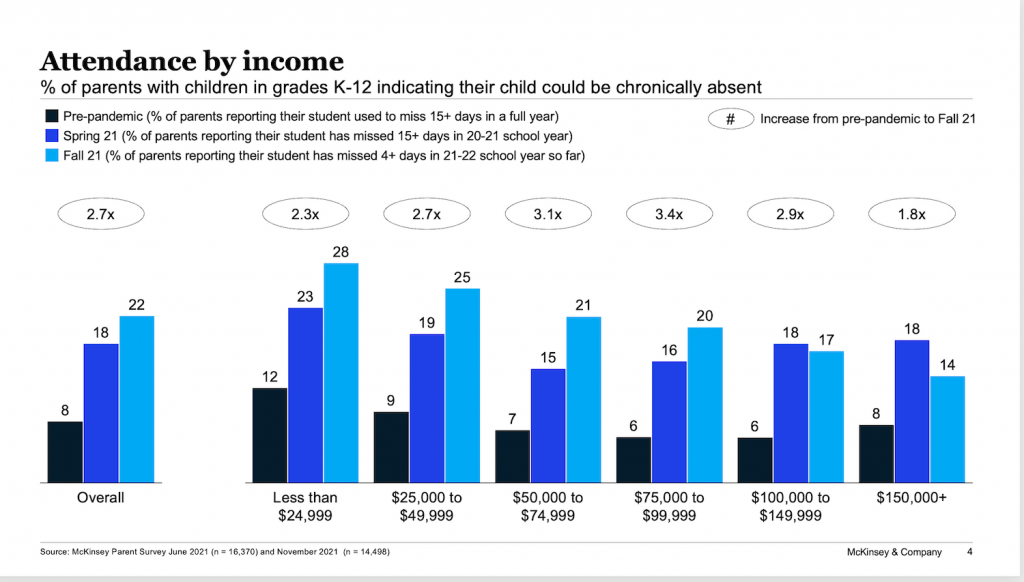Results from a new analysis of data and parent surveys from McKinsey & Company are troubling, showing an almost three-fold increase in chronic absenteeism nationwide when compared with prepandmic levels.
The data, comparing chronic absence and student achievement from spring 2020 with fall 2021, show that a full 22% of families nationwide report their child has missed so many school days this fall that they are on track to be chronically absent. This is up from the 18% of families who reported chronic absence last spring. And before Covid-19 began to close school buildings? Just 8% of parents said their child was on track to be chronically absent.
These high levels of absenteeism could translate into an additional 1.7 million to 3.3 million eighth–12th graders dropping out of school because of the pandemic, if historical correlations between chronic absence and high school graduation remain steady.
The report, COVID-19 and education: an emerging K-shaped recovery, reveals how the pandemic is further exacerbating inequities in education. For example, while chronic absence continues to increase among families with low-incomes, students in more affluent families – earning 100K or 150K or more – are starting to recover academically, and their levels of chronic absence, which were lower before the pandemic, are starting to decrease (see image inserted below).
This disparity likely reflects a number of harsh realities including, for example, that students attending low-income schools are less likely to have access to health care (including Covid testing). They are also more likely to ride public transportation, have parents working in service industry jobs which involve in-person contact with others, and live in densely populated housing.
At the same time, the achievement gap between Black and white students, which existed prior to the pandemic, has increased by about a third. The analysis shows that if current attendance trends continue, students living in low-income communities, with less access to online learning or additional support, could remain up to a grade level behind their peers.
These data show that we are not out of the woods yet. The K-shape recovery in learning mimics the country’s economic shifts, with some families remaining steady while others struggle with job loss, trauma and more cases of Covid-19.
Despite the high chronic absence rates, there are steps districts and schools can take right now to connect with students, and improve attendance and engagement in learning, especially for those most affected by the pandemic. They can build upon and tailor proven practices developed before the pandemic, such as:
- Teacher home visits: Students whose families were visited by a teacher at home, using the Parent Teacher Home Visits model, were 21% less likely to be chronically absent, compared with students whose families did not visit with a teacher at home, research shows. View our recommendations for keeping home visits safe during the pandemic in our Strategies for Connecting with Students and Families (scroll down on this page).
- Mentoring: Pairing students with a caring adult at the school in a positive, ongoing relationship can help motivate attendance. And students and families are more likely to share the barriers they face to getting to school (such as unreliable transportation, lack of access to mental or physical health care, food scarcity or unclean clothes) with an adult who meets with them regularly. Learn more from MENTOR.
- Check-ins: Working with school staff, develop procedures for checking in with families of students who are not attending. Let families know that someone from the school will be calling to check in and make sure they are okay, and to share any necessary makeup assignments to ensure that children do not miss key lessons.
Fortunately, states, districts and schools have more resources than ever to support such strategies given the availability of Covid relief funds. Use these funds for data driven strategies to address absenteeism, including outreach to students and families, intensive or high dosage tutoring with high expectations for all students, and other intensive social, emotional and mental health and support. Learn more about federal funds in our blog post.
Read the full report, including more details on the data, COVID-19 and education: An emerging K-shaped recovery.
Learn more in a recorded conversation about this report in the Campaign for Grade Level Reading webinar, The Hurt Could Last a Lifetime: Data, Growing Gaps & Rays of Hope. Emma Dorn of McKinsey & Company, Kristen Huff of Curriculum Associates and Karyn Lewis of NWEA each shared highlights from their recent reports on student progress during the pandemic. Denise Forte of The Education Trust and Cecelia Leong of Attendance Works explored how to move forward.
